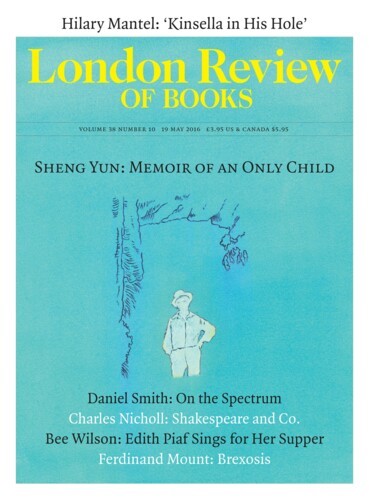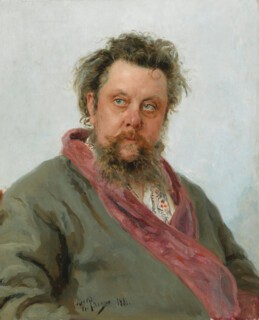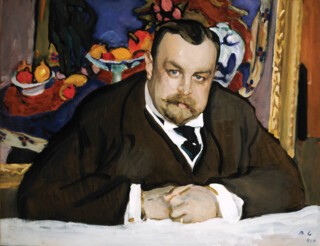The National Portrait Gallery’s Russia and the Arts: The Age of Tolstoy and Tchaikovsky (until 26 June) displays a small but rich body of works made between 1867 and 1914, focused on Russia’s writers, artists, actors, composers and patrons, most of whom will be familiar – Tolstoy, Dostoevsky, Turgenev, Chekhov, Mussorgsky, Tchaikovsky, Rimsky-Korsakov. It also takes in significant but less well-known figures, such as the formidable critic Vladimir Stasov, whose efforts did a great deal to shape the cultural scene. The portraits are drawn from the collection of the State Tretyakov Gallery in Moscow, the first museum dedicated to Russian art, amassed by the wealthy merchant collector Pavel Tretyakov. The stress is principally on the sitters, even though – in Russia – the artists who painted them enjoy equal celebrity with their literary and musical counterparts. Most important here are the groundbreaking painters of Russia’s nascent realist school, especially the Peredvizhniki (the ‘Wanderers’), though the exhibition also focuses on late 19th-century aesthetic and decorative developments ushered in by early modernist movements such as Symbolism and Diaghilev’s Mir iskusstva.
Before the 1860s, if you leave aside the traditional icon, Russian artists were mostly occupied with importing Western academic conventions. Under Peter the Great and his successors, the Empress Elizabeth and Catherine the Great, Russia’s Imperial Academy of Arts produced artists – however great their technical ability and however great their talent – who were ultimately indistinguishable from their European counterparts in style and subject matter. Not until the mid-19th century, with an essentially salon style, did Russian painters start forming a discernible national school. Vasily Perov, whose superlatively introspective portrait of Dostoevsky is a psychological meditation on the anguished intellectual, was a founding member of the Peredvizhniki, which broke the monopoly of the reactionary Academy and established (in the face of strenuous state hindrance) Russia’s first independent school of art, rooted in realism as practised by prominent members such as Ilya Repin, Ivan Kramskoy and Nikolai Yaroshenko, all represented in this exhibition.
Like many of his colleagues Repin came from peasant stock; until the liberation of the serfs in 1861 he was effectively somebody else’s property. As a student at the Academy he was propelled to notoriety with his iconic image of hard labour, Barge-Haulers on the Volga (1870-73), which prefigured a lifetime of controversial brushes with the tsarist regime over the supposedly seditious content of his major works chronicling social and political inequalities. Among them were They Did Not Expect Him (1884-88) depicting a dishevelled political exile returning to his unsuspecting family, and Ivan the Terrible (1885), a harrowing image of regal murder, which was banned from exhibition and occasioned a change in the already draconian censorship laws concerning art exhibits. Repin’s portrait of the terminally ill Mussorgsky – painted in the composer’s hospital room shortly before his death – depicts his alcohol-fuelled degeneration without sentimentality: it’s a sensitive and frank homage to a friend. By comparison his tall, slender canvas of Baroness Varvara Ikskul von Hildenbandt, looking indifferently out at the spectator from behind her veil, is an exquisite fashion plate of aristocratic Russian chic that would be equally at home in the Vogue centenary exhibition next door. The refined use of a restricted but contrasting palette of black and vivid red, enlivened by the baroness’s gold jewellery, showcases Repin’s aesthetic sensibilities and engagement with Fin-de-Siècle decorative concerns, but the sitter’s inclusion in this exhibition has more to do with her status as the founder and hostess of a celebrated salon that drew in the cultural elite of her day. Repin is the apogee of Russian art. Having survived his appropriation by Soviet Socialist Realism and the bowdlerisations of Stalinist art history, for a long time swallowed wholesale in the West as fact, he has now been ‘rehabilitated’ in canonical art history.
Valentin Serov seems to belong to another world entirely to Repin, the peasant made good, under whom he trained, and who encouraged him to experiment; he lived for a while in the Repin household following the early death of his father, the composer and music critic Aleksandr Serov. He was a much sought after portrait painter of royalty and the aristocracy, as well as cultural luminaries. In his portrait of Maria Ermolova there are echoes of Repin’s Baroness von Hildenbandt: the tall, slender figure of the imposing, self-assured actress, the controlled and minimalist Whistlerian harmony in black and grey, with sparing highlights in muted gold. Serov was courted by Diaghilev and retained close ties with Mir iskusstva. His blend of insight and elegance, without seeking to flatter his subjects, made him the pre-eminent portraitist of his day and prefigures modern developments in Russian art towards the decorative. These aspects are seen to dazzling effect in his portrait of the merchant-industrialist Ivan Morozov, the great collector of modern French and avant-garde art, shown with a recently acquired work by Matisse. This colourful tempera with heavy black outlining echoing a Post-Impressionist approach allows Serov to paint in a modern French idiom: he is exploring the artistic potential of his sitters, beyond the imperative for an accurate likeness.
There is more progressive material too. Mikhail Vrubel was an intellectual and polymath, from a privileged background not unlike Serov’s; the two artists became close collaborators. But unlike Serov, Vrubel found little recognition – critics were often hostile – and he eventually went into mental decline. Despite the modernity of his work, Vrubel saw himself as the successor to the great European traditions from Byzantium to the Renaissance. He was frequently dismissive of much contemporary art and disdainful of the democratic narratives of the realists. An abiding fascination with the decorative traditions of Russian ecclesiastical and Byzantine art led to commissions in restoration work, murals and ornamentation in cathedrals; he worked on the arts and crafts ‘Slavic Revival’ estates at Abramtsevo and Talashkino, and made theatre sets and costume designs. His portrait of his wife, the soprano Nadezhda Zabela, shows off his decorative exuberance, the colours arranged like building blocks. The ornamental arrangement of Vrubel’s forms seems the antithesis of three-dimensional art and he proved a great influence on evolving modernist trends with his interest in decoration, symbolism, fragmentation, experimentation with the paint surface and distortions of perspective and form.
The exhibition ends with works by Olga Della-Vos-Kardovskaya, who along with Osip Braz, whose portrait of Anton Chekhov is seen here, was one of Repin’s pupils at the Academy. Her decoratively symbolist portrait of Anna Akhmatova draws attention also to a period of prolific cultural activity in which innovative female practitioners would at last be noticed. For the most part, however, the zenith of Russian portraiture at the NPG is, through its focus on the architects of national culture, solidly male. It wasn’t until the early 1920s, enthusing about Vladimir Tatlin’s visionary but unfulfilled project for a Monument to the Third International – Tatlin’s Tower as it is popularly known – that the Futurist poet Vladimir Mayakovsky was moved to note that it was ‘the first Russian monument without a beard’.
Send Letters To:
The Editor
London Review of Books,
28 Little Russell Street
London, WC1A 2HN
letters@lrb.co.uk
Please include name, address, and a telephone number.



